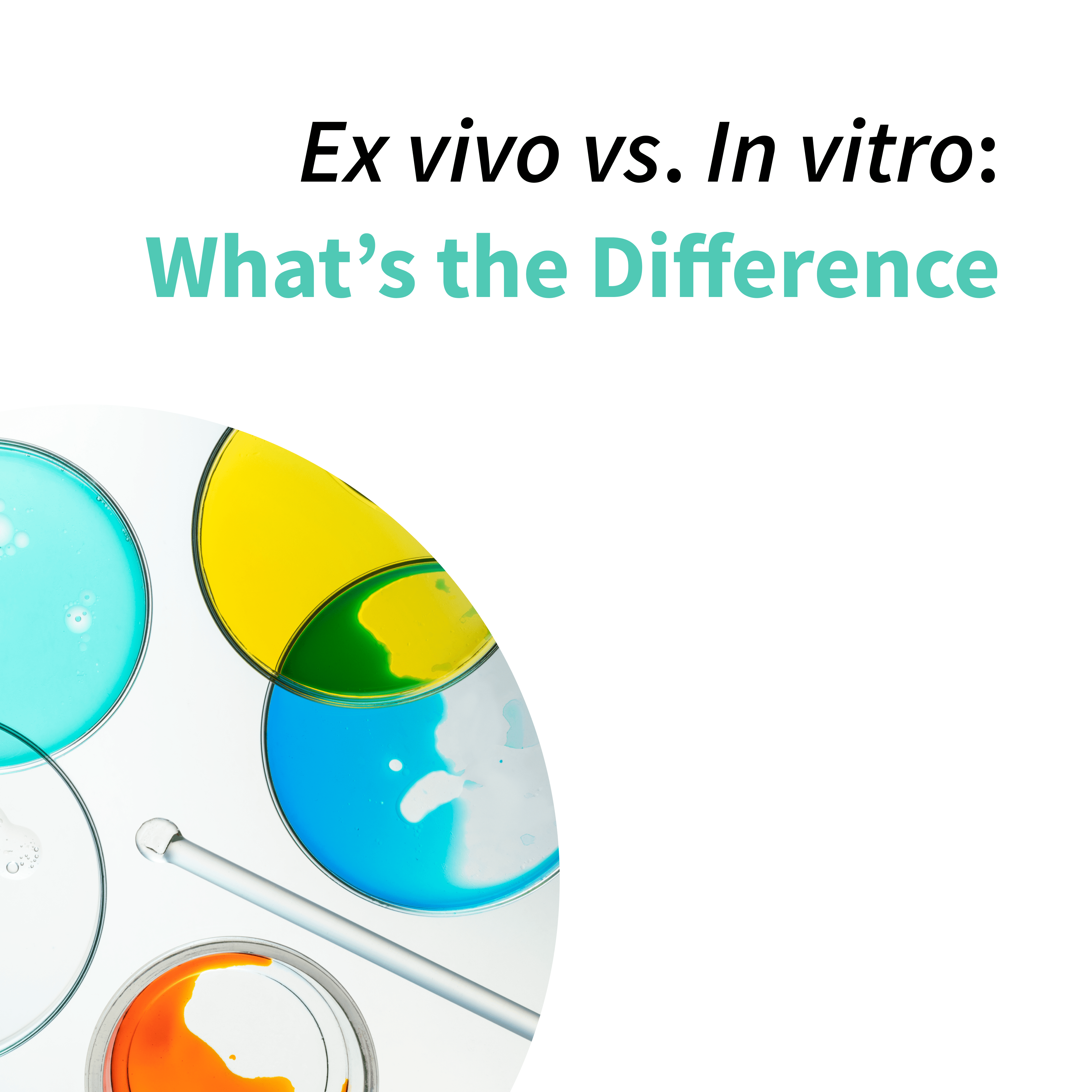Ex vivo meaning: ex vivo vs in vitro
Pre-clinical studies are a critical step in Drug Discovery and Development, as they link the Drug Discovery process and the initiation of human clinical trials. These studies are essential for understanding how a Drug works, its potential side effects, optimal dosage, and delivery method before it can be tested in humans.
Pre-clinical studies utilize in vitro and in vivo models to evaluate potential therapeutic compounds' safety, efficacy, pharmacokinetics, and pharmacodynamics. Although less known, ex vivo models are also an option for bridging the gap between less complex in vitro assays and whole-organism in vivo studies.
All these Latin terms sometimes get mixed and create confusion. What does ex vivo exactly mean? What’s the meaning of in vivo and in vitro? What’s the difference between in vitro and in vivo?
What is ex vivo?
Ex vivo, meaning out of the living in Latin, refers to experiments or procedures performed on tissues or organs extracted from a living organism and conducted outside the original biological context. These experiments are conducted in a laboratory setting, where the biological material is maintained in conditions that mimic those found within the organism as closely as possible. A simpler ex vivo definition would be taking a piece of a puzzle to look at it closely.
The architecture, including cell-extracellular matrix (ECM) and cell-cell connections, is maintained, granting that metabolic processes are closer to the in vivo state than an in vitro model.
Ex vivo models are frequently used for disease modeling, Drug Discovery and Development, regenerative medicine, and tissue engineering. Ex vivo and in vitro models represent an excellent alternative to animal testing.
What is the difference between ex vivo and in vitro?
The term in vitro is Latin for in glass, indicating that these experiments are conducted in a controlled environment outside a living organism, formerly in glass test tubes or petri dishes. Nowadays, glassware in modern laboratories has been replaced by plastic. These experiments usually involve cell culture in 2D or 3D, as in the case of spheroid and organoid culture models.
In vitro experiments often study the properties of cells, biochemical processes, or pharmacological responses in a highly controlled setting. This allows researchers to isolate specific variables and understand their effects without the complexity of a living organism.
There are three critical differences between ex vivo and in vitro:
-
Ex vivo approaches maintain a higher level of biological complexity by keeping the organ or tissue structure intact, whereas in vitro experiments are typically conducted with isolated cell(s).
-
In vitro experiments offer more control over external variables and are less complex and cost-effective, making them suitable for studying specific molecular or cellular mechanisms. These characteristics make them indispensable for high-throughput screening (HTS) of large libraries of compounds to identify potential Drug candidates, even Drug repositioning. Ex vivo experiments, while still controlled, introduce more variables due to the complexity of tissue or organ systems.
-
Ex vivo methods offer more physiologically relevant insights into the whole organism than in vitro studies because they maintain some native interactions with tissues or organs.
It is essential to highlight that although the term ex vitro may seem related to these approaches, it is primarily used in plant biology. In plant tissue culture, for example, ex vitro refers to the transition of plants or tissues from an artificial, sterile laboratory environment to a natural or greenhouse environment.
As can be seen, ex vivo systems represent a model between in vitro and in vivo that can be very resourceful for more specialized studies.
In vitro vs in vivo: What is the difference?
Finally, in vivo refers to research, experiments, or procedures in living organisms, such as animal models. This term comes from Latin, meaning within the living. In vivo methods are essential for developing and testing new medicines, vaccines, and treatments to ensure their safety and efficacy in actual living systems before they are approved for human use.
The in vivo approach sheds light and allows us to draw conclusions that cannot be obtained through in vitro or ex vivo experiments alone.
In Drug Discovery and Development, in vitro models facilitate advancement through the funnel, allowing high throughput large-scale pharmaceutical screenings. Hundreds of molecules get discarded in this phase, reducing the number of tested molecules later in vivo using research animals. In vivo testing requires institutional animal care and use committee approval and implies a series of ethical concerns, including the abuse in the use of animals for research. Policies such as the 3Rs Principles advocate its correct use.
There is a growing demand for alternative methodologies to traditional animal testing, focusing on sophisticated in vitro and ex vivo models. Ideally, these alternatives would combine the advantages of in vitro methods, such as their high throughput capabilities and cost-effectiveness, with detailed insights and reliability of animal studies.
The Zebrafish is a vertebrate animal model with high genetic homology to humans that gathers all these benefits simultaneously. They are often seen as a bridge between in vitro and in vivo models. Specifically, Zebrafish larvae offer a viable and cost-effective model that supports High Content Screening Assays without the ethical concerns typically associated with in vivo studies, as they are not classified as such when used under 5-6 days post-fertilization (dpf). Given these attributes, Zebrafish are increasingly becoming valuable in the Drug Discovery and Development process.
Sources
Cassar S, Adatto I, Freeman JL, Gamse JT, Iturria I, Lawrence C, Muriana A, Peterson RT, Van Cruchten S, Zon LI. Use of Zebrafish in Drug Discovery Toxicology. Chem Res Toxicol. 2020 Jan 21;33(1):95-118.
Piglionico SS, Pons C, Romieu O, Cuisinier F, Levallois B, Panayotov IV. In vitro, ex vivo, and in vivo models for dental pulp regeneration. J Mater Sci Mater Med. 2023 Apr 1;34(4):15



